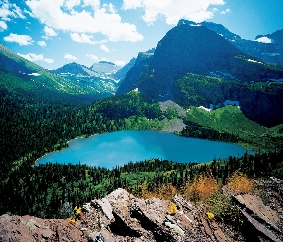Glacier National Park in Montana is a place of beauty. It has towering cliffs, jagged ridges, and deep valleys. All of these were made by ice.
That’s right: Ice carved the rocks. Of course, small pieces of ice could not do all that. But giant ice sheets could and did. Ice still covers some parts of the park.
Ice at Work
Ice sheets form when more snow falls in winter than can melt in summer. The snow never completely melts, so, year after year, the snow piles up, and huge mounds cover the land. The bottom layers of snow slowly turn into ice.
When the ice grows heavy enough, it starts to move downhill. That’s when a sheet of ice becomes a glacier. People often describe glaciers as “rivers of ice.” Some glaciers were once more than a mile thick. Only the highest mountains poked through the giant ice sheets.
This has been happening at Glacier National Park for millions of years. Glaciers have slowly moved across the land, changing the landscape. They plowed away the soil, ground down mountains, and carved out valleys.
Glaciers don’t last forever, though. If the weather heats up, they melt. That happened at Glacier National Park about 10,000 years ago. And it is happening again today.
Today, twenty-six glaciers cover parts of the park. Those glaciers are still changing the land.

Melting snow and ice formed this lake in Glacier National Park.